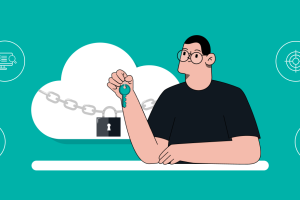Ensuring security for your traditional network is hard enough, but things get a little harder with the cloud. This isn’t because the cloud is weak. It’s just that this type of network configuration has several security concerns that you won’t have to address with a regular network. At the same time, you can ensure security if you just know what to do.
You should be utilizing at least some type of two-factor authentication to keep hackers out of your network. When preventing Cyber Crime with your business or personal computer, it is better to take that extra step instead of hoping nothing happens.
1. Control
One of the problems with cloud computing is control. You can setup an in-house traditional network without any problems. This means that the servers are at your place of business and you can physically see them. You can also see if other people are trying to tamper with the servers, and you have the most control. Nothing will happen to the network without your permission.
This becomes a problem with a cloud network because the servers are hosted somewhere else. It’s currently impossible to setup your own cloud network due to the number of servers needed. An in-house network would also remove some of the best advantages.
You must still retain control to ensure security. This means that you need to have complete access control, the encryption keys and everything else. If you can’t control the network, then you are just inviting disaster.
2. Device Theft
Hackers frequently attack businesses, but you are probably ready to counter this threat with the best antivirus programs. At the same time, device theft should be your biggest concern. You can have the best IT team and antivirus programs in the world, but they won’t be able to stop a thief or hacker that has an employee’s smartphone.
The price of easy data access from mobile devices is that anyone who steals one of these devices also has easy access to your network. Be prepared for this by pairing an anti-theft app with everyone’s smartphone. This allows you to easily wipe data as soon as the device is stolen.
You should also ensure that every employee knows who to talk to if a device is stolen. Statistics show that about 30 to 40 percent of employees don’t know what to do if they lose their smartphone.
3. Automated Controls
Even the best tech employees might miss an attack on the system. There are basic cloud security controls that can help your employees find and fight hackers as soon as they enter the network. These controls, known as preventative and corrective controls, perform several key tasks.
They will constantly scan the network for changes, alert the proper employees about the problem, fight the hacker and fix any damage that occurs to the network. While these controls aren’t foolproof, they do make the IT department’s job much easier because they can start fixing problems even if no one is monitoring the network.
4. Authentication
How easy is it for an employee to access information? Does he or she just need a password, or are there personal security questions and PIN numbers that must also be entered? A one-step authentication process is convenient, but a business network needs more security than this. This is especially true since accessing a cloud network is easy for both employees and hackers.
You should be utilizing at least a two-step authentication method to keep hackers out of the network.
5. Sensitive Data
Understand that the current cloud architecture tends to make it unsuitable for certain types of data. For example, many experts say that very sensitive documents shouldn’t be stored on the cloud. This includes credit card numbers, medical documents and critical business projects.
Sometimes the best way to ensure security on the cloud is to understand how it should be used. If you have many sensitive documents, then you should consider placing them on a traditional server that you have complete control over. This ensures that it’s much harder for hackers to access the sensitive documents.
Conclusion
Cloud networks are great for storing data and performing business transactions, but you have to ensure that the servers are secured and safe against attacks. Hackers will come for your data, but you can make the fight much harder for them by hardening the network. Be sure to have control of the network, be able to wipe an employee’s device and add a good authentication method so that hackers can’t simply enter the network.











